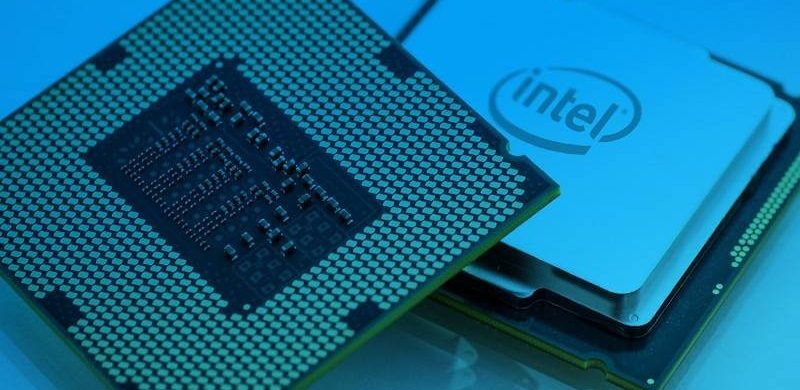
Intel announced its first Core i9 processor for desktops last year.Now, Intel is announcing its first Core i9 chip for laptops, with what it claims is “the best gaming and creation laptop processor Intel has ever built.”
The top-of-the-line model being announced today is the Intel Core i9-8950HK, which can reach speeds of up to 4.8 GHz with turbo boost and is the first mobile Intel processor to offer six cores and 12 threads. Intel claims that translates to up to a 29 percent overall speed boost over the previous seventh-generation Intel chips, with 41 percent improvement for gaming and up to 59 percent faster 4K video editing.
Along with the Core i9 processors, Intel is also announcing i5 and i7 processors for laptops, which will also be based on the company’s 14nm++ architecture (known as Coffee Lake) instead of the first wave of the eighth-generation Kaby Lake R chips, which were enhanced versions of the same 14nm+ architecture of the seventh-generation chops.
Unlike those earlier eighth-generation chips (part of the U-series of Intel’s processors), these new i9, i7, and i5 Coffee Lake chips are part of the company’s H-series line-up (along with Intel’s collaboration with AMD on the hybrid Radeon RX Vega M processors with integrated GPUs). But while the Radeon RX Vega M processors are meant for thinner and lighter laptops for companies looking to cut down on space, these new Coffee Lake chips are designed for hardware manufacturers’ top computers (presumably with more powerful discrete graphics cards) where firepower is of chief concern.
Along with the new Coffee Lake chips, Intel is adding support for its Optane memory to both the eighth-generation mobile and desktop chips, which should help increase overall speeds compared to more traditional memory systems. Intel is also introducing new Intel Core i5+, i7+, and i9+ badges to indicate that new computers feature both new Intel processors and Optane memory from the start.
Up until now, Intel has been revealing its eighth-generation Core processors at a slow but steady pace. It started with the U-series last August, which are now quad-core, whereas they’ve previously been dual-core. In October, it announced new desktop chips that are hexa-core instead of quad-core, and then at CES in January, Intel announced new quad-core H-series processors with dedicated GPUs from AMD built into them.
The H-series processors mentioned above actually have the ‘G’ suffix, and, Intel announced the actual ‘H’ chips. Obviously, the naming is a bit confusing, especially since the two lines of processors have different benefits. The ‘G’ chips are like the seventh-generation H-series processors but with a built-in dedicated GPU. There’s no dGPU on the new ‘Coffee Lake’ H-series processors, but they do now come with six cores (12 threads) instead of four.
The H-series is described as ‘high performance graphics’, and they’re made for powerful laptops, such as gaming PCs and mobile workstations. With that in mind, the big news is that Intel is bringing its Core i9 processor to laptops in the form of the Core i9-8950HK, with the ‘K’ suffix meaning that it’s unlocked for overclocking. Intel says that it can achieve a turbo frequency of up to 4.8GHz.
Historically, the suffix on locked H-series processors has been ‘HQ’, as they were quad-core. HQ chips will still exist, but the new hexa-core processors will have the suffix ‘H’, including the Core i7-8750H and i7-8850H. The Core i5-8300H and i5-8400H are quad-core with eight threads. Finally, there are new hexa-core Xeon E processors, which are also 45W.
But that’s not all that’s new for laptops, as there are also some announcements for the U-series, which is the line of processors that you’ll find in most ultra-books and convertibles. The Core i7-8259U, i5-8269U, and i7-8559U are still quad-core with eight threads, but these models come with Iris Plus graphics instead of UHD Graphics 620, which is what’s found in the existing 8th-gen processors. There’s also a Core i3-8109U with Iris Plus, but it’s dual-core with four threads.
On a side note, the seventh-generation Core i7 with Iris Plus is what’s used in Microsoft’s Surface Pro and Surface Laptop. If it seems like the products are due for an 8th-gen refresh, this could be what the company is waiting for.
Intel also expanded its eighth-generation desktop-class processor line-up, with the Core i3-8300, i5-8500, and i5-8600. The i3 is quad-core and the i5 models are hexa-core, but they’re not hyperthreaded.
But if that’s not enough, Intel announced its T-series chips too, which are described as ‘power-optimized lifestyle’. This means that they come in at 35W instead of 65W. The Core i7-8700T is hexa-core with 12 threads, while the Core i3-8100T, i3-8300T, i5-8400T, i5-8500T, and i5-8600T are once again quad-core and hexa-core, but not hyperthreaded.
There are also new vPro flavours of both mobile and desktop processors, which include Optane memory and Thunderbolt 3 support. These also include hardened multifactor authentication, improved BIOS security, and more.
Intel also said that some processors will be branded as Core i5+, i7+, and i9+, and that means that they have a combination of Intel Core performance and Optane memory.
With announcements of H-series, U-series with Iris Plus graphics, and T-series chips, the only thing missing from Intel’s eighth-generation line-up is the Y-series, which is the rebranded Core M that means ‘ultra-low power’. While the rest of the line-up has been focusing on more cores and power, it seems likely that the Y-series will continue to focus on efficiency, and it Intel could possibly be waiting for that to release its first 10nm chip.
Intel is poised to continue its dominance of the mobile computing world in 2018 with the release of new Coffee Lake H-series and U-series Intel Core processors, Core i9 CPUs for laptops, and Intel Optane taking over mobile memory.
All three new types of product are designed to give Intel what it needs to deliver top-tier performance for every laptop price point, purpose and form factor – and based on Intel’s promises and early hands-on time with several of these 8th-generation and Core i9 laptops, Intel seems well on its way to delivering.
Starting with the fun stuff, Intel Core i9 brings the firm’s most powerful CPU into the mobile space. The one and only Core i9 processor is the i9-8950HK, clocked at 2.9GHz and maxing out at 4.8GHz across its six cores and 12 threads. The processor has a relatively massive 12MB cache and is unlocked for overclocking.
Clearly, the idea with this processor is to bring desktop, hexa-core power to gaming laptops and prosumer devices. Laptops we’ve seen already that possess this power include the Asus ROG G703, Aorus X9 DT and MSI GT75 Titan.
Acer Aspire Nitro 15 – $749 (about £530, AU$980)
Sporting a faux carbon fibre lid, the Acer Nitro V 15 will be one of the more affordable Intel 8th-gen H-series laptops available starting this month.
Acer Aspire 7 – $849 (about £600, AU$1,110)
Meanwhile, Acer’s more business facing Aspire 7 brings the same level of performance to a more professional device plus higher-tier Nvidia GTX 1050 Ti graphics.
MSI GS65 Stealth – $1,799 (about £1,280, AU$2,350)
The MSI GS65 is fresh, more minimalistic take on the brand’s classic Stealth series featuring an even thinner chassis and smaller bezels.
MSI GT75 Titan – $2,399 (about £1,710, AU$3,120)
On the opposite end of the portability equation, the MSI GT75 Titan is one of the first of three gaming laptops to feature an Intel Core i9 processor for true overclocking potential.
Asus Zen Book Pro UX550
The Asus Zen Book Pro UX550 is one of the thinnest laptops that will features an H-series Coffee Lake processor
Asus ROG G703
The Asus ROG G703 pairs up the new Intel Core i9-8950HK processor with Nvidia GTX 1080 for unparalleled performance in a gaming laptop.
Samsung Odyssey Z 15
The Samsung Odyssey Z 15 was one of the only wholly new gaming laptops we saw rocking Intel’s new H-series Coffee Lake processors.
HP Omen 15
The HP Omen 15 is not only of the brands first laptops to feature a hexa-core Intel Core processor, but also a Nvidia GTX 1060 Max-Q GPU.
HP Omen 17
Featuring the same choices in processors, the HP Omen 17 also sports a larger 17.3-inch screen.
Gigabyte Aero 15X – $1,999 (about £1,420, AU$2,610)
Sporting a new logo and 0.1-inch thinner design, the Gigabyte Aero 15X continues the series’ tradition of being of the most affordable and potent gaming laptops in the world.
Aorus X9 DT – $2,599 (about £1,850, AU$3,390)
The Aorus X9 DT is the last of the four laptops to feature Intel’s Core i9 processor and to top it off this gaming laptop is equipped with a real mechanical keyboard and Nvidia GTX 1080 graphics.
ASUS TUF FX504
ASUS TUF FX504 – From AU$2,599 (about £1,425, US$2,000)
ASUS is using Intel’s mobile chip launch to kick off a new range of laptops under its The Ultimate Force (TUF) branding. The TUF FX504 will be available from the end of April in Australia only, for the time being.
Better performance for all
Unlike the laser focus on enthusiast gaming of Core i9 on mobile, Intel looks for its Coffee Lake H- and U-series to improve upon the experiences of all gamers and general users, respectively.
The H series of Intel Core processors brings hexa-core design to Intel Core i7 chips for the first time in the i7-8850H with a 2.6GHz clock speed that boosts to 4.3GHz when needed with a 9MB cache in tow. These hexa-core CPUs should make managing multiple units in strategy and other similar games much more efficient.
Intel’s Coffee Lake U-series, however, simply doubles down on the power of 8th-gen Kaby Lake R with more quad-core chips that range in clock speed from 2.3GHz to 3.0GHz and cache size from 4MB to 8MB. By Intel’s measure using a Core i5-8400U processor, this chip is 2.5x more responsive and 2.1x faster in office productivity tasks than a five-year-old system. The new U-series also integrates updated Iris Plus graphics.
To make those gains feel even greater, Intel has brought its Optane high-speed memory to laptops through both direct Optane SSDs, like the Optane SSD 800p, as well as Optane hybrid drives for disk drives paired with SSDs. According to Intel, the gains amount to 1.3x performance improvement in data writing and retrieval-related tasks, and 4.7x faster level loading in games.
Intel hasn’t laid out pricing expectations for any products containing these new processors or storage improvements, leaving that up to individual device makers. Expect to see laptops with these new processors inside laptops priced from around $500 / £400 / AU$650 starting very soon.





